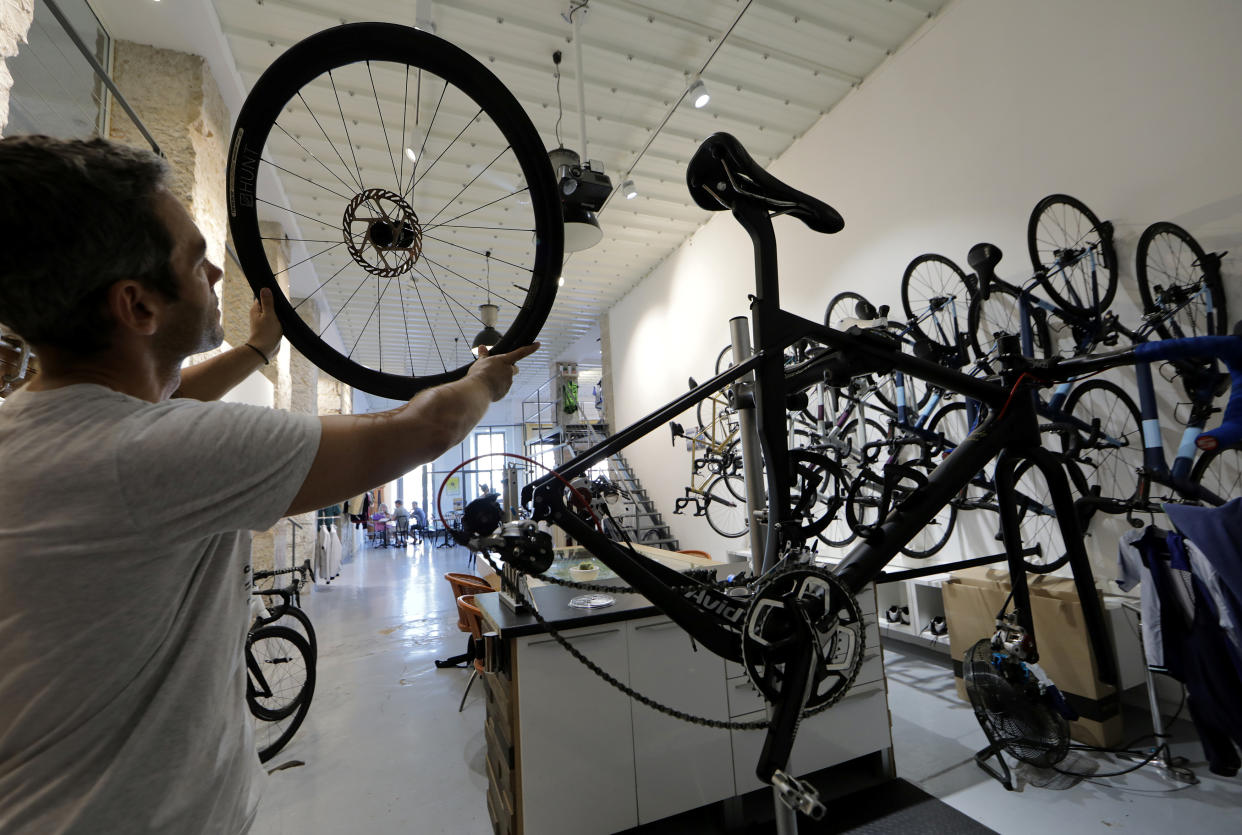The internet is transforming bike shops into community spaces

Bike shops, like many other retailers, have not fared well in the Age of Amazon, as anyone with a shop will tell you — if you’re able to find one nearby. Numbers-wise, there has been a 42% decline in bicycle shops since the millennium, Outside Magazine noted in a 2016 examination.
The main bike shop boogeyman, not surprisingly, has been Amazon and other online retailers, which has pushed prices to the bottom. Direct-to-consumer bike sellers, both high-end and those in the “Warby Parker for bikes” mold, that offer something simple and affordable have added to the misery.
A traditional bike shop business model is 20% service, 30% parts and accessories, and 50% for the sale of actual bikes, but the parts and accessories game has become almost untenable.
If a consumer wants to buy a bike part or accessory, it’s both more expensive and less convenient to get it at a shop, Joe Nocella, a lapsed architect and owner-operator of 718 Cyclery in New York, told Yahoo Finance. Prices are so low online because the bike industry has a vibrant gray market, with many accessories trading at prices far under the MSRP essentially allowing consumers to buy products at close to wholesale prices.
Shops, understanding this, often choose to carry less inventory, which means that customers will oftentimes not find items that they need in the store so they have to place an order. That order may take four days to arrive at the shop — not the consumer’s home — so the customer just ends up shopping online. It’s a vicious cycle that’s ripped a leg off the bike shop’s tripod business model, which is struggling to stay upright.
But the bike industry has a trump card that is helping the situation: People simply love bikes. Perhaps it’s because some people think it’s the closest thing to flying, or perhaps it’s because it reminds them of their youth, but every successful bike shop today owes its success to taking advantage of this social aspect of the business.
‘Creating a community’
“It’s interesting to travel to see how different bike shops have adapted,” said John Watson, who owns and runs The Radavist, a website for bicycle lovers that focuses on the outdoor experience over racing. “Your bike shop needs to be a destination. Creating a community and catering to it — that’s the most important thing.”
The harsh climate for bike shops has resulted in an almost Darwinian process of culling the establishments that are unable to create and cater to a physical community. This is creating a paradigm shift as shops that “get it” survive — or have a better shot at survival — and they are redefining what it means to be a bike shop.
It’s easy to roll your eyes at marketing buzzwords like “retail experience” and “experiential retail,” but these things can mean everything in a business that is largely patronized by people for recreation and passion, rather than pure necessity. If done right, it has the potential to transform a disparate customer base into something cohesive — fostering both customer loyalty and new business.
“One of the things we started talking about years ago is focusing on the things the internet can’t take away,” said 718’s Nocella. “The struggle is to create a reason for people to actually come to the shop.”
While service is a main facet of the business (“you can’t hammer a nail over the internet,” Nocella quipped), 718 offers shop rides, bike-packing trips, mountain bike demonstrations and race days — in New York City, of all places — women-only events, and free maintenance classes.
The community stuff isn’t full of cross-selling or lead-generating in a traditional sense, but generally done more as a longer-term investment. While it may not necessarily generate short-term sales, an excited community is often one that spends to keep it self-sufficient. Of course, the two can coexist and do, as Watson noted by pointing out a bike shop trend of offering customers coffee and beer, higher margin items.
Having a pleasant place for people to hang out may seem to some the antithesis of the bike shop, hitherto in many shops a place for surly bike dudes.
“To be a bike shop and survive in the internet realm, you really have to engage with your customers and can’t be I’m-a-grumpy-mechanic-too-cool-to-talk-to-you [attitude],” says Watson. “It’s pretty wild, you’re seeing a departure for the typical bike shop with 100 models to a more social environment and they don’t wanna get you in and out the door.”
The business
As Watson points out, the shops with 100 different bike models on the floor is gone. At his local bike shop, Golden Saddle Cyclery in Los Angeles, there is only a handful of models built-up and available for sale, as many customers elect to customize from stock bike options with the help of the shop — leveraging the value add. The retail portion is made up of accessories, parts, and gear that’s often made by smaller manufacturers who will take great pains to make sure their prices won’t get into the third-party gray-market rat race, which would eat into shops’ revenue.
On the East Coast at 718, Nocella’s shop has done a similar thing, focusing on brands that don’t undercut them. “We’ve ditched partners that undercut online, and learned how to get out of toxic relationships,” he said. “It’s a race to the bottom and we won’t participate.”
Figuring out relationships may be the most important part of the modern-day bike business. For Nocella, the community goodwill has allowed him an ace up his sleeve in the art of making deals with bike manufacturers. Typically, bike manufacturers will dictate how many bikes a shop needs to buy to be a dealer, a practice that leads to shops selling bikes at prices at deep discounts come year’s end. This is both capital-intensive and inefficient, as the shops themselves know best how their customers will behave.
Thanks to community goodwill, Nocella said he’s been able to turn the tables and dictate the terms in many deals. But at the end of the day, like Watson’s shop, a key to success is to keep inventory tight and curate.
A service industry?
For bike shops, this strategy has to work, because the alternative — providing a fully service-based shop isn’t realistic. According to Nocella, a service-based model, at least for his shop, is simply untenable given the margins, even though a tire flat change costs $17.
“One of the big rallying cries is service is going to save us. You can’t charge enough so it’s not worth it,” he said. “If you change flats all day long and do tune ups, you’d be out of business.”
Some former bike shop employees in shops that have gone by the wayside have adopted a mobile bike shop model using a van as a base so they can follow business, but even that isn’t viable.
According to Watson, high prices in Australia has led to shops like Shifter Bikes in South Yarra, Victoria, to avoid selling bikes altogether, instead focusing on service and doing builds for people with high-end parts (they sell parts for builds). But, as Watson noted, the proprietor has a bike-whisperer reputation that can demand prices for services that others may not be able to.
An overarching fear in the bike community, and perhaps even more for people who are outside of it and simply use a bicycle, is that there may not be someone there to fix the bikes when they need repairs. The successes of the “new bike shops” — fragile as some of them are — do suggest that they’ll survive and come out stronger, smarter, and more efficient than before, meaning people will be able to find a bike shop when they need one. They’ll just have to drive a little bit farther than in the old days.
Update 3/30: A previous version of this story said it was retail-free. In fact, Shifter Bikes does in fact sell bike parts.
Ethan Wolff-Mann is a senior writer at Yahoo Finance focusing on consumer issues, tech, and personal finance. Follow him on Twitter @ewolffmann.
This story is a part of Yahoo Finance Presents: The Retail Revolution, March 5-9, 2018.


